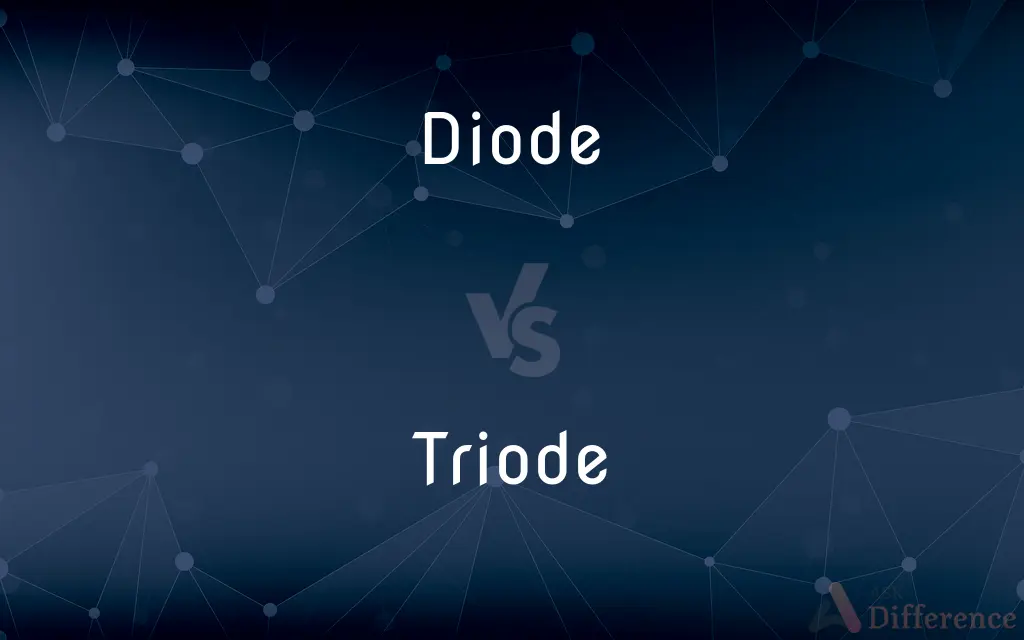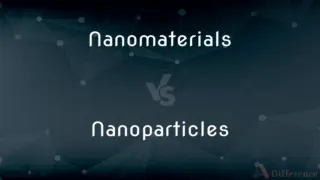Diode vs. Triode — What's the Difference?
Edited by Tayyaba Rehman — By Urooj Arif — Updated on March 8, 2024
Diodes are two-terminal electronic components allowing current flow in one direction, while triodes add a third terminal for current modulation.

Difference Between Diode and Triode
Table of Contents
ADVERTISEMENT
Key Differences
A diode is a semiconductor device with two electrodes, an anode and a cathode, designed to allow current to flow in one direction only, serving as a rectifier in circuits to convert alternating current (AC) to direct current (DC). Whereas, a triode, which includes a third terminal called the grid, placed between the anode (plate) and cathode, acts as an amplifier or switch by controlling the flow of current through the device with a voltage applied to the grid.
Diodes are crucial in power conversion and signal demodulation, relying on their unidirectional conductivity to block or pass electrical current efficiently. On the other hand, triodes, which were the first type of vacuum tubes, find their utility in amplifying or modulating signals, where the grid voltage controls the tube's conductivity, allowing for precise control over the signal's amplification.
While diodes are fundamental components in creating stable power supplies and protecting circuits from reverse polarity damage, their operation is relatively straightforward, based on the principle of allowing current to flow more easily in one direction than the other. Triodes, however, offer more complex functionality, enabling active control of electrical signals, making them essential in the early development of radio technology and audio amplification.
Diodes and triodes illustrate the evolution of electronic components from simple current control to complex signal modulation. Diodes provide the backbone for rectification and protection in electronic circuits, while triodes opened the door to the development of electronic amplification and switching, showcasing the progression from basic to more advanced electronic functionalities.
Comparison Chart
Terminals
2 (anode and cathode)
3 (anode, cathode, and grid)
ADVERTISEMENT
Function
Allows current to flow in one direction
Amplifies or modulates signals
Key Use
Rectification, signal demodulation
Amplification, signal modulation
Operation
Unidirectional current flow
Controlled current flow via the grid
Application
Power supplies, protection circuits
Radio technology, audio amplification
Compare with Definitions
Diode
Prevents reverse current flow in circuits.
Diodes are placed in parallel with sensitive components to protect them from reverse polarity damage.
Triode
A three-terminal device used to amplify or switch electronic signals.
The triode in the amplifier increases the signal strength for the loudspeaker.
Diode
Converts AC to DC in power supplies.
Diodes are used in bridge rectifiers to convert alternating current to direct current.
Triode
Pioneered electronic amplification and radio technology.
The invention of the triode marked the beginning of electronic communication by enabling amplified radio signals.
Diode
Extracts information from modulated signals.
Diodes demodulate AM radio signals by rectifying the alternating component of the signal.
Triode
Controls the flow of current for signal amplification.
Triodes are key components in tube amplifiers, providing warm audio amplification.
Diode
A two-terminal electronic device that allows current to flow in only one direction.
The diode in the circuit prevents backflow of current to protect sensitive components.
Triode
Modulates the flow of electrons between cathode and anode.
Adjusting the grid voltage in the triode varies the amplification of the signal.
Diode
Emit light when current flows through.
The LED, a type of diode, emits light when it is forward-biased in a circuit.
Triode
Acts as a switch in circuits by controlling current flow.
In early computers, triodes were used as switching elements in logic circuits.
Diode
A diode is a two-terminal electronic component that conducts current primarily in one direction (asymmetric conductance); it has low (ideally zero) resistance in one direction, and high (ideally infinite) resistance in the other. A diode vacuum tube or thermionic diode is a vacuum tube with two electrodes, a heated cathode and a plate, in which electrons can flow in only one direction, from cathode to plate.
Triode
A triode is an electronic amplifying vacuum tube (or valve in British English) consisting of three electrodes inside an evacuated glass envelope: a heated filament or cathode, a grid, and a plate (anode). Developed from Lee De Forest's 1906 Audion, a partial vacuum tube that added a grid electrode to the thermionic diode (Fleming valve), the triode was the first practical electronic amplifier and the ancestor of other types of vacuum tubes such as the tetrode and pentode.
Diode
An electrical device, such as a semiconductor or electron tube, through which flow of current is generally restricted to one direction. Diodes are often used in or as rectifiers.
Triode
An electron tube used mostly for signal amplification, consisting of a cathode, an anode, and an intervening wire mesh called a control grid.
Diode
(electronics) An electronic device that allows current to flow in one direction only; used chiefly as a rectifier.
Triode
A thermionic valve containing an anode, a cathode, and a control grid; small changes to the charge on the grid control the flow from cathode to anode, which makes amplification possible.
Diode
A thermionic tube having two electrodes; used as a rectifier
Triode
A thermionic vacuum tube having three electrodes; fluctuations of the charge on the grid control the flow from cathode to anode which making amplification possible
Diode
A semiconductor that consists of a p-n junction
Common Curiosities
What is a triode?
A triode is a vacuum tube or electronic component with three terminals (anode, cathode, and grid) used to amplify or modulate electronic signals.
What are the main uses of diodes and triodes?
Diodes are primarily used for rectification and circuit protection, while triodes are used for signal amplification and modulation.
What is a diode?
A diode is an electronic component that allows current to flow in one direction only, widely used for rectification and circuit protection.
Can a triode be used as a diode?
Technically, a triode can function as a diode if the grid is connected to the cathode, but it is not efficient or practical compared to using a dedicated diode.
What was the significance of the triode in history?
The triode was pivotal in the development of early electronic communication, including radio and audio technology, by enabling signal amplification.
How do diodes and triodes differ in construction?
Diodes consist of a semiconductor material forming a p-n junction, while triodes are vacuum tubes (or semiconductor devices) with an added grid for control.
How does a diode work?
A diode works by allowing current to flow easily from the anode to the cathode while blocking current in the opposite direction, thanks to its semiconductor construction.
How does a triode work?
A triode works by using the voltage applied to its grid to control the flow of current between the cathode and anode, thus amplifying or modulating signals.
Can a triode operate in reverse like a diode?
A triode does not operate in reverse like a diode because its function is not to block current but to control it through the grid.
What advancements have been made in triode technology?
Advancements in triode technology include the development of semiconductor triodes, like the triode transistor, offering improved performance and integration capabilities.
What replaced triodes in modern electronics?
Transistors, which are more reliable, smaller, and consume less power, have largely replaced triodes in most modern electronic applications.
Are diodes still used today?
Yes, diodes are fundamental components in modern electronic circuits, used in everything from power supplies to communication devices.
Is it easy to replace a triode with a diode?
Replacing a triode with a diode is not feasible in applications requiring amplification or active control, as diodes cannot amplify signals.
Why are triodes not as common as diodes in modern circuits?
Triodes have been largely replaced by transistors in modern circuits due to their smaller size, lower power consumption, and greater reliability.
How do diodes contribute to energy efficiency?
Diodes contribute to energy efficiency by allowing for the precise control of current flow and reducing energy loss in power conversion processes.
Share Your Discovery

Previous Comparison
Cashmere vs. Kashmir
Next Comparison
Chakra vs. ChiAuthor Spotlight
Written by
Urooj ArifUrooj is a skilled content writer at Ask Difference, known for her exceptional ability to simplify complex topics into engaging and informative content. With a passion for research and a flair for clear, concise writing, she consistently delivers articles that resonate with our diverse audience.
Edited by
Tayyaba RehmanTayyaba Rehman is a distinguished writer, currently serving as a primary contributor to askdifference.com. As a researcher in semantics and etymology, Tayyaba's passion for the complexity of languages and their distinctions has found a perfect home on the platform. Tayyaba delves into the intricacies of language, distinguishing between commonly confused words and phrases, thereby providing clarity for readers worldwide.














































